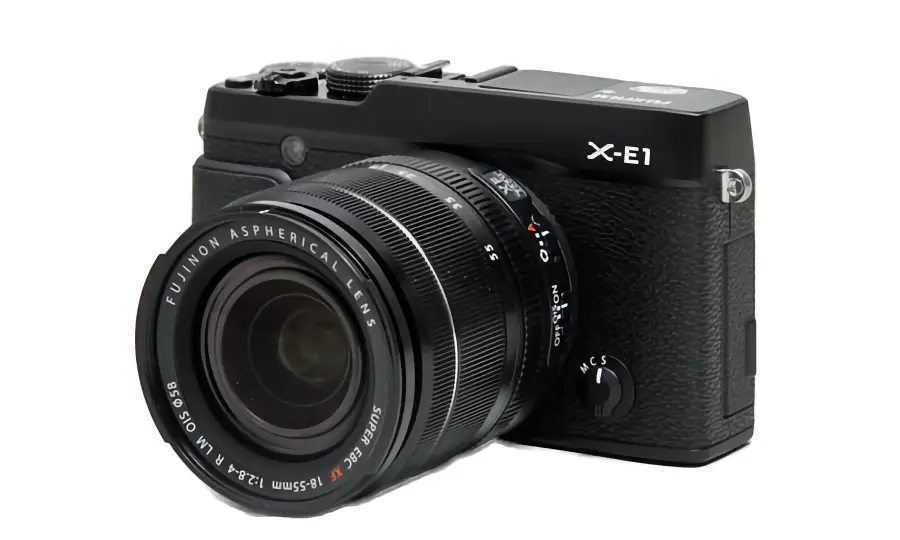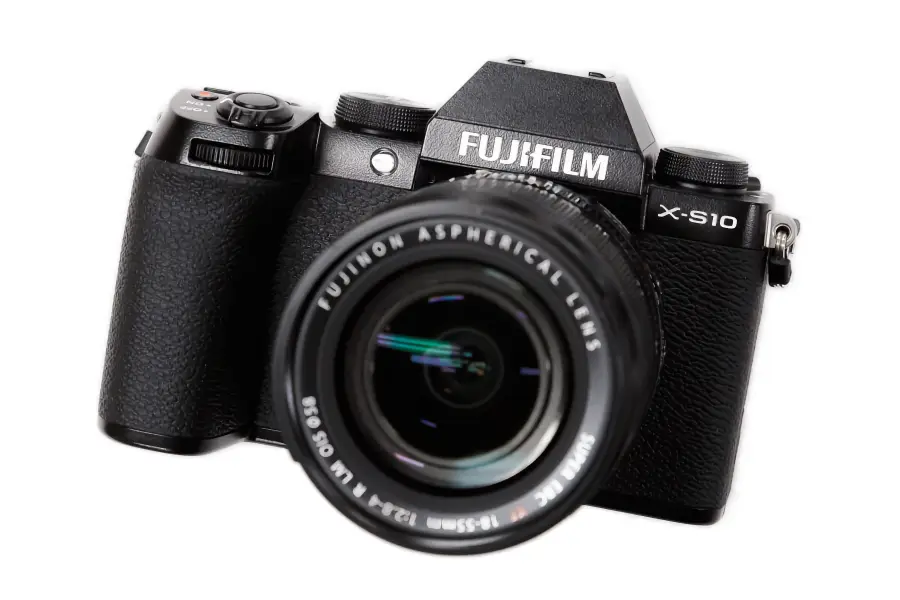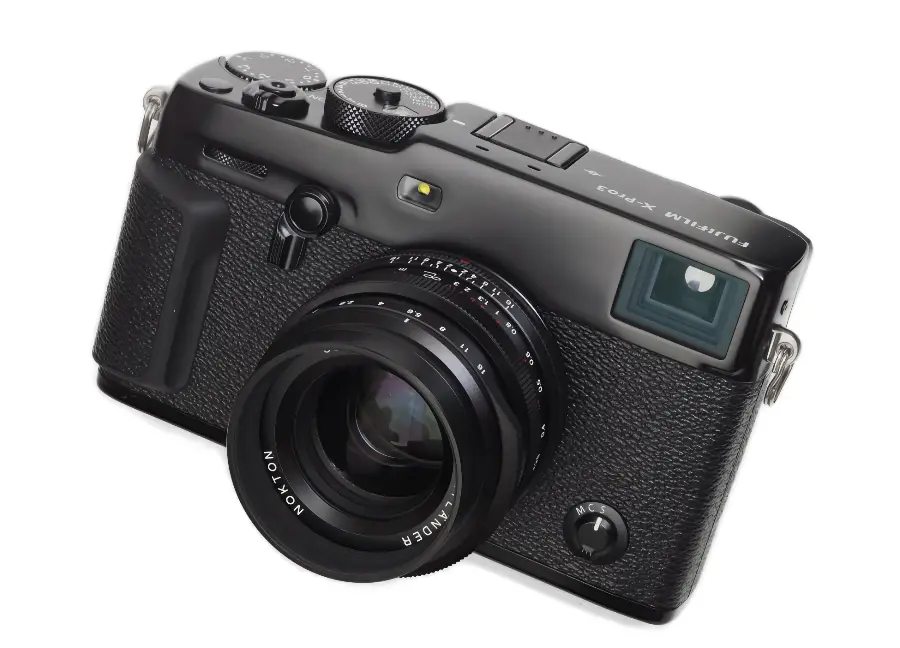
The Fujifilm X-E2, released in 2013, is a mirrorless camera that seeks to blend retro design with modern functionality. In this review, we’ll take a detailed look at the X-E2’s key features, pros and cons, and real-world performance. We’ll explore its position in the current camera market and determine which users it’s best suited for.
Key Specifications
| Specification | Details |
|---|---|
| Sensor | 16.3MP X-Trans CMOS II (APS-C) |
| Processor | EXR Processor II |
| ISO Range | 200-6400 (expandable to 100-25600) |
| Continuous Shooting | Up to 7fps |
| Autofocus | Hybrid AF (Phase detection + Contrast AF) |
| Screen | 3-inch 1,040K dot fixed LCD |
| Viewfinder | 2.36 million dot OLED EVF |
| Video | 1080/60p |
| Weight | Approx. 350g (including battery and memory card) |
| Dimensions | 129 x 74.9 x 37.2 mm |
| Battery Life | Approx. 350 shots (CIPA standard) |
| Storage Media | SD/SDHC/SDXC cards |
| Wi-Fi | Built-in |
🎨 Design & Build Quality
Classic Retro Design

One of the Fujifilm X-E2’s most appealing aspects is its classic retro design. Inspired by traditional rangefinder cameras, this design is not just aesthetically pleasing but also offers practical advantages in use.
Ergonomic Grip

The compact body features an appropriate grip, allowing for comfortable shooting even during extended use. The size and weight are particularly suitable for users with smaller hands.
Durable Body

The magnesium alloy body provides a lightweight yet robust feel. This contributes to its durability over long-term use.
📸 Image Quality & Performance
X-Trans CMOS II Sensor

The X-E2 features a 16.3MP X-Trans CMOS II sensor. This sensor uses a unique color filter array different from the traditional Bayer pattern, reducing moiré effects and delivering sharper images.
EXR Processor II

The introduction of a new image processor has improved overall processing speed. This translates to faster AF performance and improved continuous shooting speed.
Film Simulation Modes

Fujifilm’s strength in film simulation modes has been expanded. You can digitally recreate various film looks including Provia, Velvia, Astia, and Classic Chrome.
🔍 Viewfinder & LCD

High-Resolution OLED Electronic Viewfinder
The 2.36 million dot OLED EVF provides sharp image quality and fast response times. Notably, the lag time has been significantly improved compared to the X-E1.
3-inch High-Resolution LCD
The 3-inch LCD with 1,040K dot resolution allows for clear image confirmation. However, the lack of tilt or touch functionality remains a drawback.
🎛️ Handling & User Experience
Intuitive Dial Operation

The shutter speed and exposure compensation dials on top of the camera replicate the operation style of traditional cameras. This allows for quick and intuitive setting changes.
Customizable Buttons

Various function buttons on the camera body can be customized to the user’s preferences, providing a personalized shooting experience.
Improved Menu System
The menu structure has been made more intuitive compared to the X-E1. The Q Menu allows quick access to frequently used settings.
🔧 Autofocus & Burst Performance

Hybrid AF System
The X-E2 employs a hybrid AF system combining phase detection and contrast AF. This has significantly improved AF speed and accuracy compared to the X-E1.
Enhanced Continuous Shooting Performance
Supporting up to 7fps continuous shooting, a slight improvement from the X-E1’s 6fps, making it more advantageous for capturing moving subjects.
📽️ Video Capabilities
Full HD Video Recording
The X-E2 supports full HD video recording at 1080/60p. The 60fps frame rate allows for smooth video, particularly beneficial for scenes with a lot of movement.
External Microphone Support
A 3.5mm microphone input jack allows for better audio quality in video recording. This is particularly useful for vlogging or simple interview setups.
🔋 Battery Life & Connectivity

Adequate Battery Life
Offering about 350 shots (CIPA standard) on a single charge. While sufficient for a day of light shooting, it’s advisable to carry spare batteries for extended outings.
Added Wi-Fi Functionality
The X-E2 newly includes Wi-Fi functionality. This enables image transfer to smartphones and remote shooting capabilities.
📊 Comparison with Competitors
vs Sony A6000
The Sony A6000 is a popular model released around the same time as the X-E2. While the A6000 offers a 24MP sensor and faster AF system, the X-E2 boasts more intuitive controls and superior color reproduction.
vs Olympus OM-D E-M10
The Olympus OM-D E-M10, a Micro Four Thirds system camera, is smaller and lighter than the X-E2. While the E-M10 offers in-body image stabilization, the X-E2 provides better low-light performance due to its larger sensor size.
vs Fujifilm X-T10
Compared to the Fujifilm X-T10 from the same X series, the X-E2 is more suitable for users who prefer a rangefinder-style design. While the X-T10 offers a tilt screen, the X-E2 boasts a more compact body.
🔍 Lens Compatibility & Selection

Advantages of the Fujifilm X Mount
The X-E2 uses Fujifilm’s X mount, allowing access to a wide range of high-quality lenses. There’s a broad selection from premium XF series lenses to more economical XC series options.
Recommended Lenses
- XF 35mm f/1.4 R: This standard prime lens pairs perfectly with the X-E2. Its excellent rendering and fast aperture make it versatile for various situations.
- XF 18-55mm f/2.8-4 R LM OIS: A standard zoom lens that’s versatile and offers good image quality.
- XF 23mm f/2 R WR: A compact and lightweight wide-angle lens suitable for street photography.
💡 Usage Tips & Tricks

Utilizing Film Simulations
Make the most of Fujifilm’s film simulation modes. Provia offers balanced colors suitable for general situations, Velvia is ideal for vibrant landscape photos, and Classic Chrome provides subdued tones perfect for street photography.
Shooting RAW+JPEG
The X-E2 can capture both RAW and JPEG simultaneously. This feature allows you to quickly review images in JPEG format on-site while retaining the flexibility to edit RAW files later.
Leveraging Electronic Shutter
The X-E2 supports an electronic shutter with speeds up to 1/32000 second. This allows for using large apertures even in bright environments, enabling more diverse expressions.
📱 Utilizing Wi-Fi Features
Smartphone Integration
Through the Fujifilm Camera Remote app, you can remotely control the camera and transfer photos to your smartphone. This is particularly useful for selfies or group photos.
Instant Sharing
The Wi-Fi functionality allows for immediate sharing of captured photos on social media. This can be particularly useful when traveling or shooting events.
💰 Price & Value

Position in the Used Market
As of 2024, the X-E2 can be purchased at very competitive prices in the used market. The body alone typically ranges from $200 to $300, offering excellent value for money.
Choice for Beginners and Intermediate Users
The intuitive operation, excellent image quality, and reasonable price make the X-E2 suitable for a wide range of users from beginners to intermediate photographers.
🔧 Maintenance & Durability

Durability
The magnesium alloy body contributes to its robustness. Many X-E2 users have reported using their cameras for years without issues, testifying to its durability.
Firmware Updates
Fujifilm consistently provides firmware updates to improve functionality and fix bugs. Keeping the latest firmware ensures better performance and stability.
📸 Real-World Experience & User Reviews

Many users express satisfaction with the X-E2’s image quality and handling. Fujifilm’s unique color rendition and film simulation modes receive particularly high praise. However, some users point out the fixed LCD and limited video capabilities as drawbacks.
One user commented, “The X-E2 completely changed my photography style. Thanks to the film simulation modes, I’ve significantly reduced post-processing time and can focus more on the shooting itself.”
🏞️ Landscape Photography Tips

When shooting landscapes with the X-E2, consider these tips:
- Use a tripod: This ensures sharper images in low-light conditions.
- Utilize filters: ND or polarizing filters can enhance your creative options.
- Try the Velvia film simulation: This provides vivid colors ideal for landscape shots.
👤 Portrait Photography Tips
Tips for utilizing the X-E2 for portrait photography:
- Use the XF 56mm f/1.2 R lens: This lens provides beautiful bokeh and sharp portraits.
- Try the Astia film simulation: It offers soft tones that flatter skin.
- Leverage face detection AF: This ensures accurate focus for sharp portrait shots.
🌃 Night Photography Tips

X-E2 settings for night photography:
- Tripod is essential: This prevents camera shake for sharp images.
- Use low ISO: Minimize noise by using the lowest possible ISO.
- Long exposure times: This can capture light trails or brighten dark scenes.
🔄 Upgrade Path
If you’re considering upgrading from the X-E2 to a higher-spec camera, you might want to consider the following models:
- Fujifilm X-E3: The successor in the X-E series, offering a touchscreen and 4K video capabilities.
- Fujifilm X-T20: Provides a tilt screen and more advanced AF system.
- Fujifilm X-T30: Offers higher resolution and enhanced video performance.
📊 Summary of Pros and Cons

Pros
- Classic and beautiful design
- Excellent image quality and color reproduction
- Intuitive operation
- Various film simulation modes
- Built-in Wi-Fi functionality
- Strong X mount lens lineup
Cons
- Fixed LCD screen
- Low resolution by modern standards (16.3MP)
- Limited video capabilities (no 4K)
- Slower AF speed compared to latest models
- Somewhat short battery life
🏁 Conclusion

The Fujifilm X-E2 remains an attractive option even in 2024. It’s particularly ideal for photography enthusiasts who prefer classic designs and hands-on camera control. While it may not boast all the latest technology, its excellent image quality, intuitive operation, and above all, the pure joy of photography it provides, are the X-E2’s major strengths.
Of course, there are drawbacks such as the fixed LCD or limited video capabilities, but these may not be significant issues depending on the primary use and individual shooting style. Especially for users focusing on street, landscape, and everyday snapshot photography, it can still be an appealing choice.
In conclusion, the Fujifilm X-E2 is highly recommended for photographers who want to experience an analog-like feel in the digital age. Considering its affordable price in the used market, it can be evaluated as a high-value camera. However, if the latest technology or high-resolution images are essential for your needs, you might want to consider more recent models.
The X-E2 serves as a reminder that great photography isn’t always about having the latest gear. It’s about the photographer’s vision, creativity, and the ability to capture moments. For those who appreciate the process of photography as much as the final image, the X-E2 offers a unique and rewarding experience.







